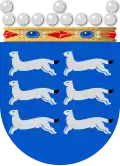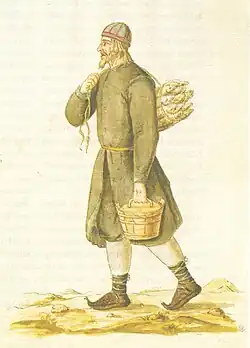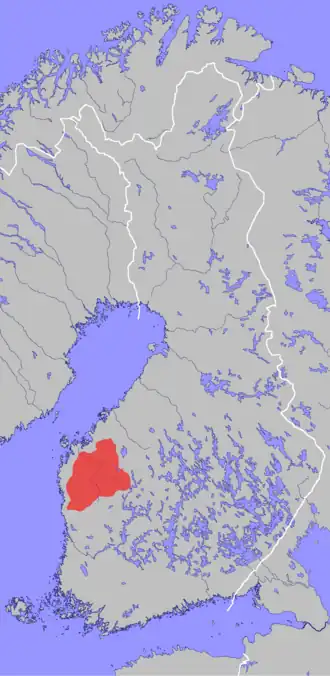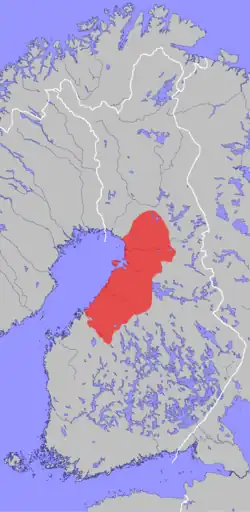Ostrobothnians
 Coat of arms of the historical province of Ostrobothnia | |
| Regions with significant populations | |
|---|---|
| South, Central and North Ostrobothnia | |
| Languages | |
| Finnish (South, Central and Northern Ostrobothnian dialects) | |
| Religion | |
| Lutheranism (Awakening and Laestadianism) | |
| Related ethnic groups | |
| Other Finns |
Ostrobothnians (Finnish: Pohjalaiset, IPA: [ˈpohjɑˌlɑi̯set]) are a subgroup (heimo) of the Finnish people who live in the areas of the historical province of Ostrobothnia in the northwestern parts of Finland.
History

_p111_%C3%96sterbotten_Bride_and_Groom.jpg)
Ostrobothnians descend from Tavastians and Savonians, the latter started to settle in Ostrobothnia during the 1500s.[1][2]
A notable historical event involving the Ostrobothnians is the Cudgel War, in which peasants led by the local rebel leader Jaakko Ilkka rose in a revolt against the nobility during the Swedish rule.[3]
Dialects

The South Ostrobothnian dialect is characterized by the changed of /d/ in Finnish to /r/ in Ostrobothnia leh(e)ren (Finnish: lehden, lit. 'leaf's'), the middle vowel in tylysä (Finnish: tylsä, lit. 'boring') and the diphthongs uo, yö and ie changing into ua, yä and iä.[4]

The Central and North Ostrobothnian dialects have been influenced by the Savonian dialects. They have changed the written Finnish sound of /t͡s/ into /s:/ or /ʰt/ and the vowels -ea and -eä into -ia and -iä.[5]
Culture
Descriptions
The stereotypical Ostrobothnian is brave, calm and dependable.[6][7][8]
National dresses and textiles
-
 Woman in Veteli national dress.
Woman in Veteli national dress.
Religion
Many Ostrobothnians are either Laestadians,[9] or active in the Awakening movement (körttiläisyys).[10]
Notable Ostrobothnians
- Alvar Aalto, architect and designer
- Heidi Hautala, politician
- Antti Isotalo, criminal and Puukkojunkkari
- Jussi Jokinen, ice hockey player
- Kyösti Kallio, president of Finland between 1937-1940
- Mari Kiviniemi, politician
- Jorma Kontio, harness racing driver
- Petri Kontiola, ice hockey player
- Pekka Korpi, harness racing driver
- Timo Kotipelto, musician
- Vilho Lampi, painter
- Jari-Matti Latvala, rally driver
- Jarppi Leppälä, stunt performer and member of The Dudesons
- Juha Mieto, cross-country skier
- Teemu Mäki, artist and writer
- Antti Niemi, footballer
- Janne Niinimaa, ice hockey player
- Jorma Ollila, businessman and former CEO of Nokia
- Jorma Panula, conductor and composer
- Tero Pitkämäki, athlete
- Erkki Raappana, Major General
- Jukka Rautakorpi, ice hockey coach
- Topi Sorsakoski, singer
- Jutta Urpilainen, politician
- Hannu Väisänen, artist, painter and writer
- Juha Väätäinen, athlete
- Niilo Yli-Vainio, preacher
See also
References
- ^ "Suomen heimojen peruspiirteet". Turun Sanomat (in Finnish). 2003-12-28. Retrieved 2021-05-29.
- ^ Lappalainen, Tuuli; Koivumäki, Satu; Salmela, Elina; Huoponen, Kirsi; Sistonen, Pertti; Savontaus, Marja-Liisa; Lahermo, Päivi (2006). "Regional differences among the Finns: A Y-chromosomal perspective". Gene. 376 (2): 207–215. doi:10.1016/j.gene.2006.03.004. PMID 16644145.
Geographically, Northern Ostrobothnia is in the west but it was populated from Eastern Finland during the 1500s, and is thus genetically regarded as an eastern province.
- ^ "Nuijasota oli hyvin verinen sisällissota – Kunnaksen uusi Koiramäki-kirja kertoo siitäkin lapsille sopivasti". Yle Uutiset (in Finnish). 25 October 2017. Retrieved 2021-05-26.
- ^ "Eteläpohjalaisten murteiden piirteitä". sokl.uef.fi. Retrieved 2021-05-26.
- ^ "Keski- ja pohjoispohjalaisia murrepiirteitä". sokl.uef.fi. Retrieved 2021-05-26.
- ^ "Suomen heimojen peruspiirteet". Turun Sanomat (in Finnish). 2003-12-28. Retrieved 2021-05-26.
- ^ "Professori Hannu Katajamäki: Pohjalaiset ymmärretään usein väärin". Studio55.fi (in Finnish). 2009-11-04. Retrieved 2021-05-26.
- ^ "Heimoerot: pohjalaiset". yle.fi (in Finnish). Retrieved 2021-05-26.
- ^ "Lestadiolaiset pitävät Pohjois-Pohjanmaan väkiluvun kasvussa". Kaleva (in Finnish). Retrieved 2021-05-26.
- ^ "Körttiläiset". yle.fi (in Finnish). Retrieved 2021-05-26.